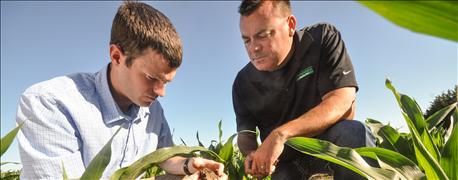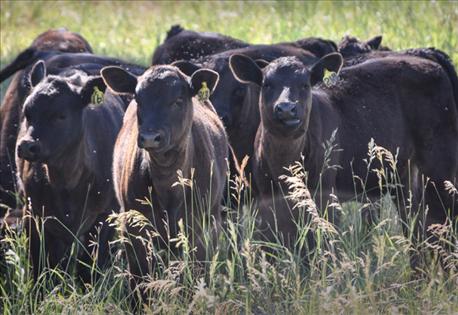July 29, 2016

Veteran no-till farmers Jason Degenhardt and his family farming partners have long witnessed the benefits of foregoing the plow in lieu of the no-till drill. Decreased erosion and increased moisture retention are at the top of that list.
But for several years, the 42-year-old Hebron farmer has been looking for other conservation practices that could be incorporated into his farming operation, which would boost production and — because water is the key limiting production factor in central Nebraska — improve water-holding capacity and infiltration.

SOIL SAMPLING: Jason Degenhardt (right) and NRCS soil health specialist Aaron Hird examine a soil sample for structure and for earthworms. (Photo credit: Ron Nichols)
"We have been no-tilling for so long we have got a mulch built up on our soil surfaces of a high-carbon residue, corn stubble, wheat stubble, and I don't think we are fully utilizing that resource," Degenhardt says. "So we were looking at how we could cycle those nutrients, get them into the soil, improve our organic matter, increase soil microorganisms and eventually improve our water-holding capacity."
The secret, he believes, is in the soil. More specifically, roots in the soil via cover crops.
To put that theory to the test, last year Degenhardt and his partners planted their first season of covers.
"I know cover crops utilize some moisture during the season," Degenhardt says, adding, "but I think the long-term benefits of it will overshadow the short-term impacts."
And although it's still too early to fully realize the benefits of cover crops, he's convinced cover crops are already helping with water infiltration on the farm.

EXTRA GRAZING DAYS: In addition to long-term conservation benefits, cover crops have provided an excellent source of diverse grazing and feed for Jason Degenhardt's cattle in the first year. (Photo credit: Ron Nichols)
"There is probably a long way to go, but we will continue to monitor those infiltration rates through our work with the Natural Resources Conservation Service [NRCS]," Degenhardt says. "But I am confident that we have already made some improvements there."
Through the NRCS Environmental Quality Incentives Program (EQIP), Degenhardt is implementing "Adaptive Management with the use of Cover Crops." An associated three-year demonstration project is designed to show changes in infiltration rates while testing other factors such as the use of different cover-crop mixes, grazed versus un-grazed cover crops, and broadcast seeding verses drilled or direct seeding.
"We're going to map our harvest and see what differences we have," he says. "We will know more at harvest, but I guess I'm not too caught up in the fact that I have to get immediate results this year. I am looking more at, after we do this for two or three years, are we going to really improve water infiltration?"
In addition to growing corn, soybeans and wheat, Degenhardt's operation includes beef production. The cover crops that he's banking on to provide longer-term conservation benefits have provided an excellent source of diverse grazing and feed for the cattle in the first year.
Another immediate benefit of using cover crops is Degenhardt's increasing knowledge about how to use them effectively as an agronomic management tool. Off the farm, Degenhardt works for an agricultural retailer, supplying chemicals, fertilizers and seeds to farmers throughout the region.
"In my role as an ag retailer, I get a lot of customers who inquire with us about what we know about cover crops, our experiences with cover crops and how we help them," he says. "So part of the reason I've been so interested in covers is to find a way to help our customers better. I thought it was important that we try it firsthand on our operation, and give our customers that experience as well."
That personal, practical experience with cover crops is the foundation for Degenhardt's advice to other farmers considering the practice.
"Don't just do it because someone else is doing it," he says. "You have to have some interest in it and some genuine interest in adapting your programs, processes and management in order to fit a cover-cropping system. It's important to know your objectives and what you are trying to accomplish."
And despite the wide array of possible cover-crop mixes, Degenhardt recommends keeping it simple.
"Start simple with something that you can manage, and plan for any challenges that you have throughout the season so that you are ready to adapt your systems to fit with that cover crop," he says.
Aaron Hird, NRCS' soil health specialist in Nebraska, says farmers throughout the state are increasingly interested in improving soil health for many of the same reasons Degenhardt and his farming partners are.
"When you improve the health of our living soil, you improve the way it functions. That means the soil can more effectively absorb and retain water and cycle nutrients to improve plant health and farm productivity," Hird says. "Those benefits translate into more resilient, profitable and sustainable farms."
In short, Hird says, "Healthy soil is good for the business of farming."
That word is apparently spreading. As part of NRCS' EQIP program, Degenhardt hosted a field day that was attended by 80 farmers this past December.
"There are a dozen growers or more who heard about that field day, and they are already talking about attending one next year," Degenhardt says.
Nichols is public affairs officer at USDA's Natural Resources Conservation Service.
You May Also Like




